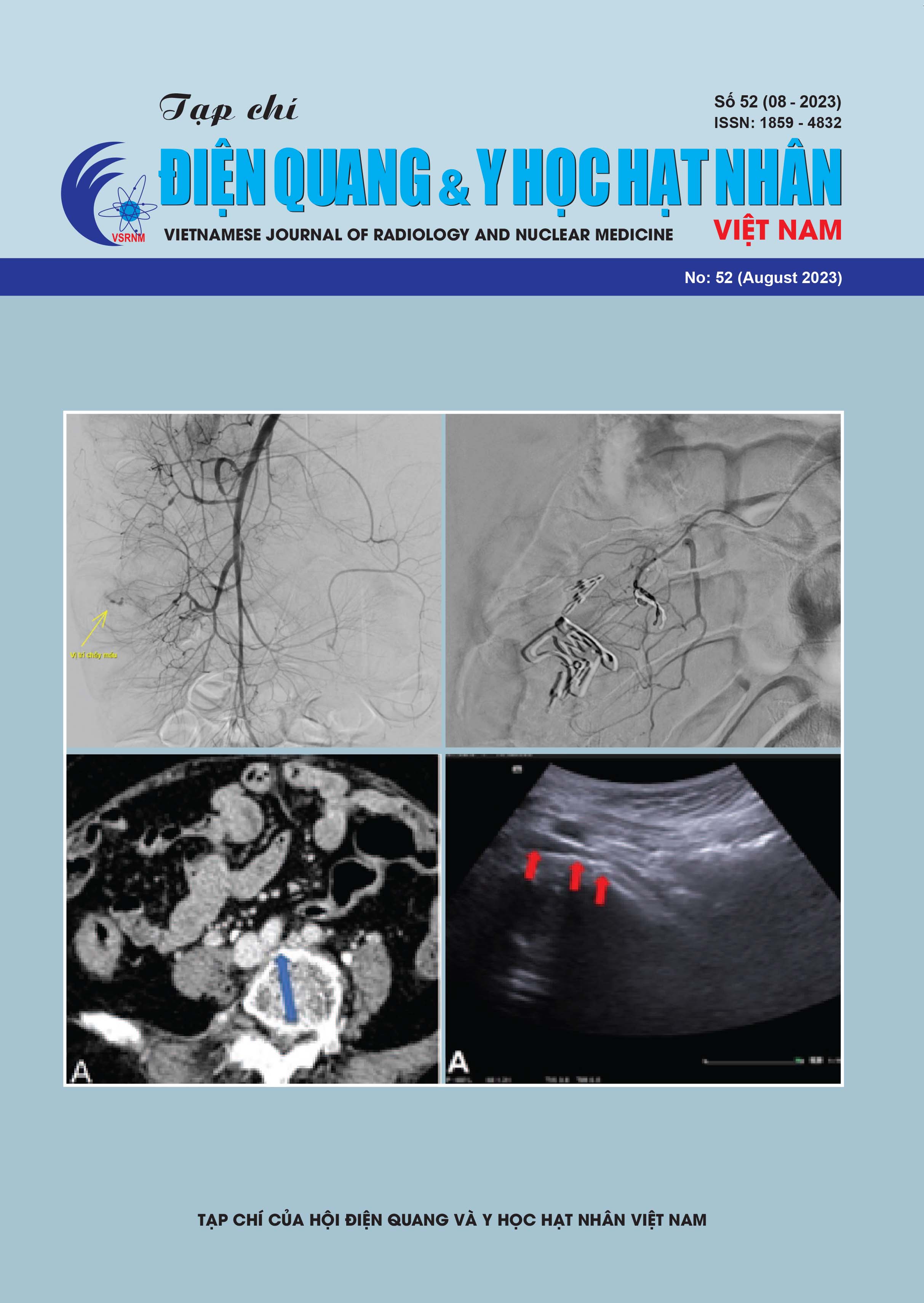TƯƠNG QUAN GIỮA ĐƠN VỊ HOUNSFIELD Ở CỘT SỐNG THẮT LƯNG VÀ MẬT ĐỘ XƯƠNG ĐO BẰNG DEXA Ở NGƯỜI VIỆT NAM
Nội dung chính của bài viết
Tóm tắt
Đặt vấn đề: Loãng xương là bệnh lý làm tăng nguy cơ gãy xương. Đánh giá đơn vị Hounsfield (HU) ở cột sống thắt lưng (CSTL) trên chụp cắt lớp vi tính (CLVT) vì lý do bất kỳ có khả năng dự đoán bất thường mật độ xương góp phần cảnh báo loãng xương. Mục tiêu: Đánh giá mối tương quan của HU tại CSTL với kết quả mật độ xương (BMD) đo bằng phương pháp hấp thụ tia X kép (DEXA).
Đối tượng và phương pháp nghiên cứu: Nghiên cứu hồi cứu và cắt ngang mô tả trên 150 bệnh nhân (BN) có thực hiện CLVT qua vùng bụng vì bất cứ lý do nào và DEXA cách nhau không quá 6 tháng. Đo HU tại các thân sống thắt lưng từ L1 đến L4. Đối chiếu với kết quả DEXA, tính hệ số tương quan Spearman của HU và BMD, tính diện tích dưới đường cong (AUC) và chọn điểm cắt HU để phân biệt giữa nhóm bình thường và thiếu xương – loãng xương, giữa thiếu xương và loãng xương.
Kết quả: Có mối tương quan thuận có ý nghĩa giữa HU trung bình tại cột sống thắt lưng (từ L1 đến L4) và mật độ xương đo bằng DEXA, tương quan mạnh nhất tại thân sống L2 (hệ số tương quan Spearman là 0,68). HU thân sống L2 ≥ 131 HU tương ứng mật độ xương bình thường, 101 – 131 HU tương ứng thiếu xương, ≤ 101 HU tương ứng loãng xương (độ nhạy và độ đặc hiệu #70%). Trong phân biệt mật độ xương bình thường và thiếu xương – loãng xương, ngưỡng cắt ≥ 101HU có Se ≥ 90% và ngưỡng cắt ≥ 171 HU có Sp ≥ 90% cho nhóm bình thường; trong phân biệt thiếu xương và loãng xương ngưỡng cắt ≤ 132 HU có Se ≥ 90% và điểm cắt ≤ 62 HU có Sp ≥ 90% cho nhóm loãng xương.
Kết luận: Có mối tương quan có ý nghĩa giữa HU tại CSTL và BMD đo bằng DEXA. HU tại CSTL có giá trị trong dự báo tình trạng bất thường mật độ xương.
Chi tiết bài viết
Từ khóa
loãng xương, phương pháp hấp thụ tia X kép, đơn vị Hounsfield tại cột sống thắt lưng
Tài liệu tham khảo
2. Radiol, J.A.C., ACR Appropriateness Criteria® Osteoporosis and Bone Mineral Density. Journal of the American College of Radiology, 2017. 14 (5S): p. S189-S202.
3. Genant, H.K., et al., Comparison of semiquantitative visual and quantitative morphometric assessment of prevalent and incident vertebral fractures in osteoporosis The Study of Osteoporotic Fractures Research Group. J Bone Miner Res, 1996. 11 (7): p. 984-96.
4. Kanis, J.A.J.O.i., Assessment of fracture risk and its application to screening for postmenopausal osteoporosis: synopsis of a WHO report. 1994. 4 (6): p. 368-381.
5. Pickhardt, P.J., et al., Opportunistic screening for osteoporosis using abdominal computed tomography scans obtained for other indications. Ann Intern Med, 2013. 158 (8): p. 588-95.
6. E, A., M. D, and A. E, Opportunistic screening for osteoporosis by routine CT in Southern Europe. Osteoporos Int., 2017. 28 (3): p. 983-990.
7. Kim, K.J., et al., Hounsfield Units on Lumbar Computed Tomography for Predicting Regional Bone Mineral Density. Open Medicine, 2019. 14: p. 545-551.
8. MK, C., K. SM, and L. JK, Diagnostic efficacy of Hounsfield units in spine CT for the assessment of real bone mineral density of degenerative spine: correlation study between T-scores determined by DEXA scan and Hounsfield units from CT. Acta Neurochir (Wien), 2016. 158 (7): p. 1421-1427.
9. Buckens, C.F., et al., Opportunistic screening for osteoporosis on routine computed tomography? An external validation study. 2015. 25 (7): p. 2074-2079.
10. Romme, E.A., et al., Bone attenuation on routine chest CT correlates with bone mineral density on DXA in patients with COPD. 2012. 27(11): p. 2338-2343.
11. Lee, S.Y., et al., Reliability and validity of lower extremity computed tomography as a screening tool for osteoporosis. 2015. 26 (4): p. 1387-1394.
12. Marinova, M., et al., Use of routine thoracic and abdominal computed tomography scans for assessing bone mineral density and detecting osteoporosis. 2015. 31(10): p. 1871-1881.
13. Lee, S., et al., Correlation between bone mineral density measured by dual-energy X-ray absorptiometry and Hounsfield units measured by diagnostic CT in lumbar spine. 2013. 54 (5): p. 384-389.
14. Pu, H., et al., Correlation between wrist bone mineral density measured by dual-energy X-ray absorptiometry and Hounsfield Units value measured by CT in lumbar spine. 2022.
15. Emohare, O., et al., Opportunistic computed tomography screening shows a high incidence of osteoporosis in ankylosing spondylitis patients with acute vertebral fractures. 2015. 18 (1): p. 17-21.
16. Batawil, N. and S.J.R. Sabiq, Hounsfield unit for the diagnosis of bone mineral density disease: a proof of concept study. 2016. 22 (2): p. e93-e98.
17. Alawi, M., et al., Dual-energy X-ray absorptiometry (DEXA) scan versus computed tomography for bone density assessment. 2021. 13 (2).
18. Kara, K., et al., The diagnosis of osteoporosis by measuring lumbar vertebrae density with MDCT: a comparative study with quantitative computerized tomography (QCT). 2013. 29: p. 775-779


